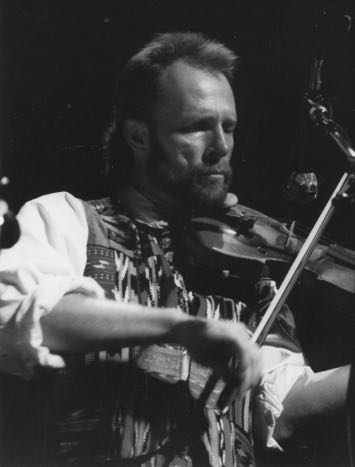
JOE CRAVEN
Joe Craven’s brilliance on string instruments such as fiddle, mandolin, saz, cuatro, and a world of percussion instruments is the stuff of local legend and national acclaim. But there’s more to Craven than meets the ear. He is not only a musician but also a visual artist, museologist (museum science), educator, loving father, avid runner, and an advocate of “demystifying” art and making music a household phenomenon.
Since 1989, Joe Craven has been a highly respected sideman with the David Grisman Quintet. He has kept impressive musical company over the years, playing and/ or recording with Jerry Garcia, Stephane Grappelli, Bonnie Raitt, Ramblin’ Jack Elliott, Tom Waits, Tony Rice, The Persuasions, Mark O’Connor, Psychograss, Darol Anger, Rob Ickes, The Turtle Island String Quartet, and many others. He is a sought after studio musician and has performed music & sound effects on a wide variety of recordings including commercials, soundtracks, computer games, and several Grammy nominated projects. His musicianship is also featured in the 2001 Sony Pictures Release, “Grateful Dawg.”
Joe Craven is a musical archeologist, bringing fresh interpretations to archival treasures. “I love how the process of folk music works…pieces learned from the aural tradition of observation – homemade and handed down person to person – generation to generation: Tunes and songs embellished and altered with different versions through time creating new music altogether. In the world we live in, when you learn other people’s music you learn about your own,” Craven says. His critically acclaimed debut release, “Camptown,” is a testimony to this folk music philosophy.
The Joe Craven Trio performs nationally, promoting Joe’s release “Camptown” – a collection of traditional fiddle tunes set to an international panorama of world inspired rhythms and instrumentation. The trio consists of Joe on mandolin, violin and various other string instruments, percussion and vocals; John R. Burrr on keyboards and key bass; and Kendrick Freeman on drums and percussion. Joe has also completed a recording project based on new interpretations of American folk songs.
Joe Craven began performing music on electric guitar in rock bands during his high school years. At the University of South Carolina, Joe received a Bachelor of Arts degree in Museology and Aesthetics and concurrently began his long-term romance with the mandolin. Upon completing his degree in 1979, Joe moved West. He continued to play mandolin, exploring folk, bluegrass and swing while working for a museum in Reno, Nevada. He later managed an art gallery in Reno and, after that, as a visual artist, exhibited his own work from San Francisco to Santa Fe.
A few of his own paintings now adorn the walls of Joe’s Northern California home, along with a riot of colorful Indonesian and Tibetan masks, kachinas, large-brimmed hats of all kinds, historical string and percussion instruments, bookcases filled with tomes on art, eclectic CDs, old cowboy boots, pictures of his family of six at various ages, and other family memorabilia. Joe’s house is a virtual museum of personal, musical and multi-cultural artifacts and a visual testament to the diversity of his creative explorations.
According to Joe, “Music is about expression, imagination and living in the creative spirit. It doesn’t need labels as much as it needs opportunity. Through exploration, practice and sincerity of application, you can make music on just about anything.” And he’s proven his point by playing everything from dashboards to squeeze toys to his head. Joe’s clinics, workshops and school presentations on demystifying music are captivating audiences around the country. He’s worked with students from preschool to adult in a variety of settings. He completed his first artist in residency at California State University – Chico to rave reviews and has expanded his educational outreach to museums and music camps ranging from Irish fiddle to international percussion. “It’s great to just pick up things like an empty bottle or your wallet and discover their inherent musical qualities, as well as your own,” he says. “It’s not the thing, but the process of how you connect with it that makes great music.”